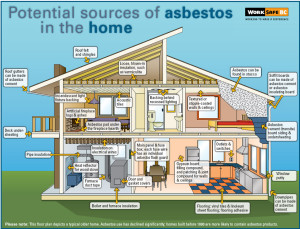Many buildings built before 1990 will contain asbestos (and potentially high levels of lead). Some of these materials can be determined through a visual inspection, for example: vermiculite insulation, asbestos board/tape, transite siding. Ultimately a qualified person needs to perform a hazardous materials survey and conduct invasive sampling throughout the structure to know with certainty which materials do or do not contain asbestos.
You may be Buying Asbestos if you are purchasing a building built before 1990.
Many of us do live with asbestos and if the material is in good condition and left undisturbed it shouldn’t cause a safety risk. If you plan to renovate, repair, or demolish that structure you are required to conduct a hazmat survey and address any asbestos containing materials prior to work starting.
Purchasing and Insuring a Home.
The cost of removing asbestos has begun to affect not only the way homeowners proceed with repairs and renovations, but it can also affect the cost of purchasing and insuring a home.
Some Mortgage companies want the asbestos removed before they will finance, and insurance companies may not insure without a clearance letter, which can affect the price of a home.
 Before you buy a home.
Before you buy a home.
If the seller is aware of asbestos in their home they are required to declare its presence on the Property Disclosure Statement. If a seller knowingly omits that information they can be sued in civil court – if the buyer later finds out that the information was intentionally withheld. Note, many home owners may not be aware of asbestos in their home because in most cases a laboratory analysis is required to determine this. If asbestos was removed from their home there should be a Removal Certificate along with the information about the property.
Home inspectors may identify some of the visually identifiable types of asbestos but unless you have a full hazmat survey of the structure you can not be certain.
Your Options – If Asbestos is discovered
If the seller, asbestos building inspector, or hazmat survey discloses the existence of asbestos, the potential buyer has several options.
- you may request that the seller seal or isolate the asbestos-containing material. This can sometimes be accomplished without incurring much cost and will operate as a suitable safety mechanism in some instances. The problem with this approach is that you will be taking on this asbestos and may have to deal with it in the future, insurance, when you resell the house, future regulation, etc. Often it can be difficult to fully isolate, seal or encapsulate the problem areas.
- not all products that contain asbestos are harmful or problematic if left undisturbed. You can simply be aware that the asbestos is present and continue with the purchase.
- you may terminate the agreement, provided that the Agreement contained the appropriate conditions or warranty. This is an extreme remedy, but may be the most cost-effective and safest in some situations. It is not uncommon to have $15,000 of asbestos abatement in a home.
- the buyer could request that the seller remove all material that contains asbestos. This should be done by professionals, who are appropriately trained in the safe-handling of asbestos.
- In the best case scenario the home seller will allow you to contract a qualified professional to conduct a hazmat survey as a condition of sale – only then will you fully realize what does and does not contain asbestos.
For more information on the health risks associated with asbestos, please talk to your doctor or the local Health Unit. The key is to be realistic, while ensuring a safe living environment.



